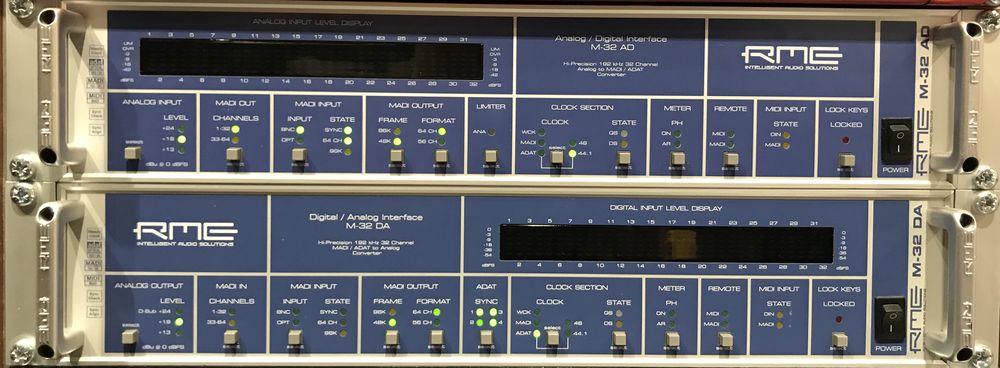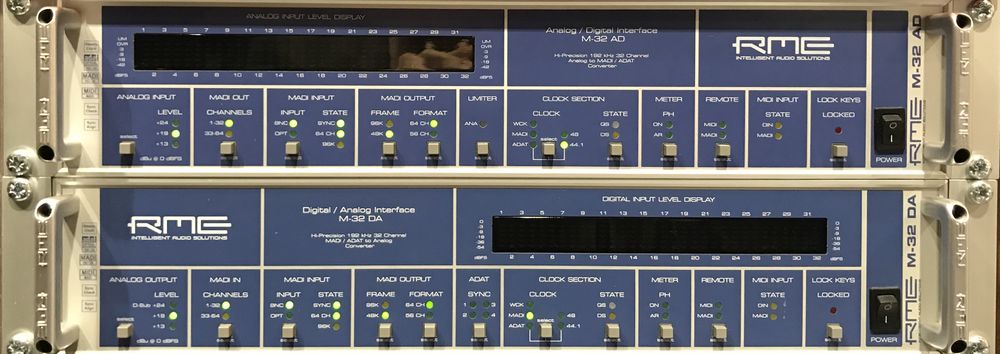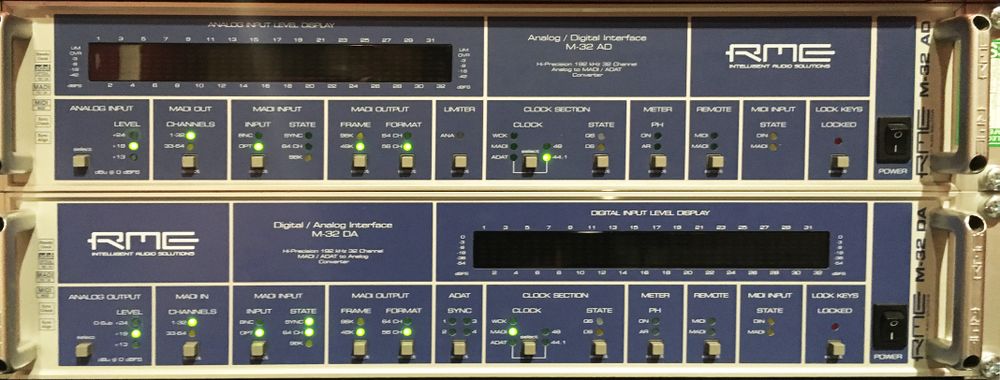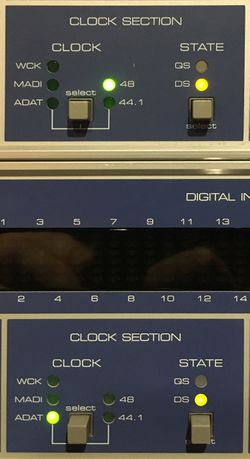RME M-32 Audio Interfaces
Recording Studios 1 through 6 in New Adelphi use the RME M32 AD/DA combination for digital conversion, encoding analogue signal into digital information and back again. Unlike converters you may be used to when using an audio interface at home, where encoding and transfer are often combined, the RME interfaces blindly convert analogue audio into a selection of different digital formats. The process of transferring this digital signal into the computer is handled separately by a selection of additional interfaces. Which ones you use will depend upon your choice of DAW.
REMEMBER: IF YOU ARE EVER UNSURE ABOUT HOW TO USE THE RME ASK AT THE STUDIO OFFICE FOR HELP!
USING THE WRONG SETTINGS CAN COMPLETELY RUIN A WHOLE SESSIONS WORK.
The RME M32s act autonomously so any changes you might need to make, such as changing your sample rate, need to be made on the front panels of the units. Changes will not be carried over to your chosen DAW automatically; these settings need to be made to match. For example, if you want to record in Logic at 44.1kHz, you have to make sure that the sample rate matches both in your Logic project and on the RME converters.
Contents
Clocking with the RMEs
As standard, the RME M32 AD (top unit) acts as a local master clock for each studio, keeping the digital converters and the computer interface in synchronisation with one another. This ensures stability when recording and ensures you avoid any nasty pops and clicks when recording. For the majority of the time this will mean that the AD unit's Clock Section will simply show the sample rate at which you are intending to record, usually 44.1kHz.
Instead of generating a master clock signal locally, you can use the New Adelphi Master Clock by setting the RME M32 AD Clock Section to "WCK", meaning Word Clock. However, this is fixed at a sample rate of 48kHz, so your session must also be configured to run at this rate. There are details as to why the house clock runs at 48kHz on the Master Clock wiki page.
Using the RMEs with Logic
When using Logic with the RMEs the digital protocol used is ADAT, you might be familiar with this phrase. The RMEs send the converted audio to a PCI card held within a metal chassis (the mysterious black box with the blue light either above or below the RME M32s) and finally this is connected via an extra long optical thunderbolt cable to the iMac in the recording studio.
In the image provided you can see how the RMEs should look when recording in Logic at 44.1khz, unless you wish to experiment with other sample rates this is how you will mostly likely be recording most of the time in Logic. The top box (the M32 AD) is operating as the Master Clock in this instance and so simply shows the intended sample rate in the clock section, so long as this is your intended sample rate this box remains much the same for each different set up.
The second RME (the M32 DA), which handles conversion of audio back into the analogue domain, requires the most adjustment between different standard recording setups. Ensure the ADAT lights have been selected by pressing the button below the 4 lights in the ADAT section and also ensure the clock section has ADAT selected as well by pressing the left button in the clock section until ADAT is selected.
In Logic your project sample rate matches the one selected on the RME M32 AD and select HDSPe as your recording interface.
Using the RMEs with ProTools HD
When using ProTools HD with the RMEs the digital protocol used is MADI using the BNC cable option, the MADI protocol can be used with either BNC or Optical cable options. The RMEs send the converted audio to the AVID HD Madi interface unit, above the RME M32s, which in turn connects to a ProTools HDX PCIe card held within a metal chassis and finally this is connected via an extra long optical thunderbolt cable to the iMac in the recording studio.
In the image provided you can see how the RMEs should look when recording in ProTools HD at 44.1khz, remember you cannot change your sample rate after you have started a new project so make sure you choose the right sample rate at the beginning of your session. The top box (the M32 AD) is operating as the Master Clock in this instance and so simply shows the intended sample rate in the clock section, so long as this is your intended sample rate this box remains much the same for each different set up.
The second RME (the M32 DA), which handles conversion of audio back into the analogue domain, requires the most adjustment between different standard recording setups. Ensure MADI is selected by turning off the four ADAT lights (if they are on), you can then toggle between BNC and OPT (optical) in the MADI input setting, ensure BNC is selected. Finally make sure your clock selection is set to MADI, if you are using higher sample rate you may need to adjust the "state", please see below for more details.
Using the RMEs with Your Own Laptop
It is possible in all the different studios to use your own laptop as a substitute for the provided iMac, studios 1-6 use RME's Madiface technology to allow for near complete integration with the studio. Your laptop can be connected to the Madiface using a USB cable which in turn transfers digital audio to and from the RME M32 converters using the optical cable option.
Firstly you will need to download and install the RME Madiface drivers and software to your laptop, these can be found on the RME website and then ensure the RME is set to the same settings as in the image above. You will also need to ensure your settings match those on the front RME M32s in the "Fireface" dialogue box that appears upon connecting the Madiface to your computer.
Using Different Sample Rates
Once you have set the RME M32s to the correct settings for your chosen DAW you may wish to work in a different sample rate than the standard 44.1khz. The RME M32s offer conversion capabilities of up to 192khz however the most common alternative you might find yourself using is 48khz.
The RME M32 AD (the top unit) should always read the sample rate that you intend to work in, it does this through a combination of two different settings, the "clock" on the top unit should read as either 44.1khz or 48khz and the "state" should either be unlit, be set to DS (double speed) or QS (quadruple speed). The combination of these two is your resultant clock speed, for example 48khz at double speed results in a sample rate of 96khz.
The bottom unit should have the appropriate "clock" source selected such as "ADAT" if you are working with Logic or Madi if using Protools or the Madiface. The "state" however should always follow whatever you have selected on the top unit.
The table below shows the full options for different sample rate selection.
| Sample Rate | M32 AD "clock" | M32 AD "state" |
|---|---|---|
| 44.1khz | 44.1 | Off |
| 48khz | 48 | Off |
| 88.2khz | 44.1 | DS |
| 96khz | 48 | DS |
| 176.4khz | 44.1 | QS |
| 192khz | 48 | QS |
Total Mix
Total Mix is the software provided by RME to manage the routing of your outputs and inputs, it allows us to listen back to audio post conversion on the long faders of the desk with almost no latency whilst recording audio on the short faders. It also lets us decide where we might want to route out DAW outputs, so if you were working on a desk with less output you could potentially combine signals to double up.
You do not need to worry about most of this as in the recording studios two default settings have been added for ease of use with everything routed how one might expect it to be. The two presets available are "Record" and "Mix", you will see these on the righthand side when opening Total Mix. It's important to make sure you use these appropriately when you are in your studio session, if ever you find nothing being routed into the computer is coming back on the long faders then it is very likely Total Mix is in "Mix" mode, switch to record mode and this problem will be solved. Likewise if you are planning to do a large mix across the desk or do any routing out of your chosen DAW to the outboard gear in the studio it is important to use "Mix" mode as using the "Record" preset in this scenario can result in nasty (and potentially dangerous) feedback loops.
If you are using the Madiface feel free to ask a member of the recording studios staff to check that your Total Mix is set up correctly.



